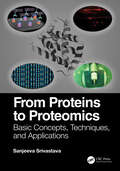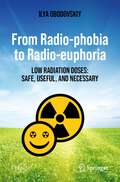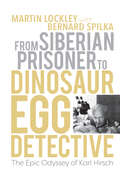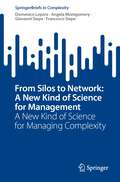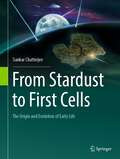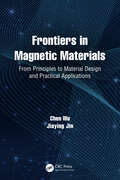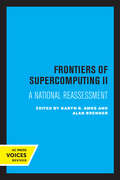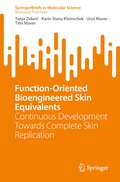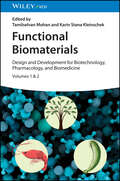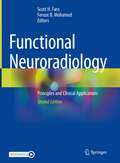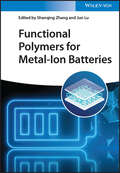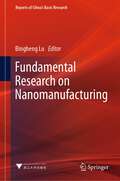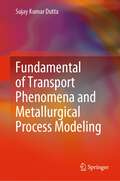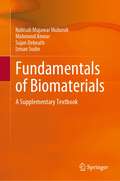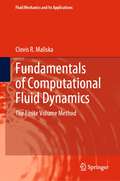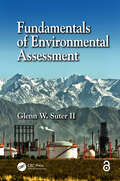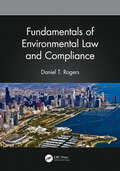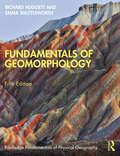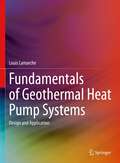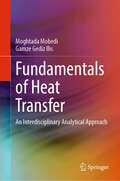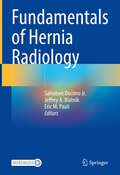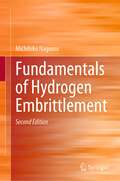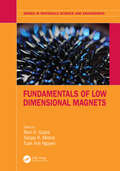- Table View
- List View
From Proteins to Proteomics: Basic Concepts, Techniques, and Applications
by Sanjeeva SrivastavaProteomics aims to study all the proteins of human and other living systems, as well as their properties to provide an integrated view of cellular processes. The study of proteomics involves the application of rapidly evolving high-throughput technologies and new platforms that are coming forward regularly, providing versatile novel tools for biomedical and pharmaceutical applications. This book provides a detailed understanding of the basics of proteins and proteomics, gel based-proteomics techniques, basics of mass spectrometry and quantitative proteomics, interactomics: basics and applications, and advancements in proteomics. It also covers basic knowledge about sample preparation, mass spectrometry workflow, different chromatography technologies and quantitative proteomics. The text highlights the application and challenges of various high-throughput integrated proteomics technologies capable of fast and accurate screening of thousands of biomolecules, which are found to be very effective for studying disease pathobiology and identification of next-generation biomarkers and potential drug/vaccine targets; and are therefore considered valuable tools for multidisciplinary research. Features Basics of proteins and proteomics techniques In-depth understanding of mass spectrometry and quantitative proteomics An overview of interactomics and its application for translational research Advancement in the field of proteomics and challenges in clinical applications We hope the knowledge gained from reading this book will intrigue and motivate young minds to explore future opportunities in the constantly evolving field of proteomics.
From Radio-phobia to Radio-euphoria: Low Radiation Doses: Safe, Useful, and Necessary (Springer Praxis Books)
by Ilya ObodovskiyThis book gives a detailed discussion of the initial enthusiasm triggered by the discovery of x-rays and radioactive radiation which later turned into fear and repulsion in a significant part of the global population up to the 21st century.After a historical review, the author discusses the effect of ionizing radiation on living cells, tissues and organisms. He then describes the relationship between the dose of radiation and the effect it produces. He shows how the dose-effect dependence is measured and what models of describing such dependences are used. He also discusses how radiation acts on living organisms: disorders in the genetic apparatus, mutation formation and so on. The book also includes detailed descriptions of the results of numerous health studies of large groups of people who, for one reason or another, were exposed to low doses of ionizing radiation, including those that significantly exceed the natural radiation background. The author concludes that low doses of radiation are safe and can even be beneficial (as known from medical radiation treatment); and also that the natural radiation background is necessary for the normal growth and development and well-being of a living organism. The author also discusses cases and effects of large doses, arguing, however, that dangerous doses of radiation are very unlikely. This book challenges radio-phobia. It not only offers arguments helping to overcome an unreasonable fear but, based on the latest understanding of science, argues to gradually move back, not to the former radio-euphoria, but to a new, conscious attitude towards radiation.
From Siberian Prisoner to Dinosaur Egg Detective: The Epic Odyssey of Karl Hirsch (Life of the Past)
by Martin LockleyThe inspiring story of the man who doggedly sought the secrets hidden within dinosaur eggs.From Siberian Prisoner to Dinosaur Egg Detective explores the fascinating story of Karl Franz Hirsch (1921–1996). After serving in the German army in WWII, being wounded and captured by the Soviets in Danzig and then sent to a prisoner of war camp in Siberia, Hirsch went on to become one of the world's leading experts on fossil eggs. After starting a new life in Colorado, Hirsch became an avid fossil hunter and one day discovered by accident a dinosaur egg. Armed with curiosity and a microscope, he began to study it. In 1979, at the age of 58, Hirsch published his first scientific paper on fossil eggs. Hirsch went on to write dozens of influential technical papers and collaborate with professional paleontologists at the University of Colorado Boulder and elsewhere. At his death, his immense research collection consisted of 35,000 photographs, 20,000 pages of notes, and 3000 fossil egg specimens. From Siberian Prisoner to Dinosaur Egg Detective presents Hirsch's inspiring life story, demonstrating how brilliance and determination are key ingredients in the advancement of scientific understanding.
From Silos to Network: A New Kind of Science for Managing Complexity (SpringerBriefs in Complexity)
by Domenico Lepore Angela Montgomery Giovanni Siepe Francesco SiepeThis book provides the conceptual framework and a comprehensive guide to the principles, methods and tools for managing organizations. The authors introduce “New Knowledge” by presenting a methodology, 'The Decalogue’, that portrays a genuinely systemic approach for managing complexity in organizations and Value Chains through focusing on the management of a leverage point called constraint (Theory of Constraints) and the understanding of variation (Theory of Profound Knowledge). This systemic approach leverages the intrinsic process and project-based nature of the work of organizations. Functional hierarchy is replaced by a network-like structure, driven by the goal of the system and governed by a new design of the organization called “Network of Projects”. The transition towards the Network of Projects requires a cognitive shift in the way we view and put to good use human talent and ingenuity as well as a powerful algorithm to orchestrate and synchronize individual competencies.The authors discuss at length this algorithm, how the Theory of Constraints helps in the cognitive challenges of this shift and also how technology can be used fruitfully to assist with the operational implications. The target audience for this book is made up of leaders and managers of organizations as well as researchers and practitioners in the field of management and organizational design.
From Stardust to First Cells: The Origin and Evolution of Early Life
by Sankar ChatterjeeThis book presents a groundbreaking hypothesis to answer one of the greatest scientific mysteries: How did life begin? Like a detective piecing together seemingly disparate bits of evidence, Dr. Sankar Chatterjee combines the most recent discoveries in cosmology, geology, chemistry, information systems, and biology, weaving a vast tapestry from the threads of current research. Dr. Chatterjee convincingly argues that the odyssey of life first began when the fundamental building blocks were brought to Earth by meteorites. These cosmic compounds concentrated and simmered like a soup in hydrothermal crater-caldrons. Through a system of subterranean vent networks, a biosynthetic-rich variety of organic compounds mixed and matched into a recipe of rich biomolecules guided by prebiotic information systems. Through symbiosis, these complex biopolymers gradually assemble into membrane-bound protocells. At each stage of this evolutionary progression, through natural selection, they refined with increasing stability and complexity, ultimately leading to the emergence of the first cells about four billion years ago. In this book, Dr. Chatterjee tells this story in rigorous detail in language that is both accessible and engaging.
Frontiers in Magnetic Materials: From Principles to Material Design and Practical Applications
by Chen Wu Jiaying JinThe book aims to provide comprehensive and practical guidance on magnetism and magnetic materials. It involves four parts, focusing on fundamental magnetism, hard magnetic materials, soft magnetic materials and other functional magnetic materials. Part I highlights the ubiquity of magnetism and the close relationships between magnetic materials and our daily life. Perspectives on magnetism from Engineering and Physics are provided to introduce the two unit systems, followed by the origin and categories of magnetisms. An introduction of important parameters during magnetization and magnetic measurement techniques are then provided to lay a solid foundation for the readers for better understandings of the design and development of different magnetic materials. Important magnetic materials are then introduced in the subsequent parts, delivering an overview of design principles, production technologies, research developments and real-world applications. For instance, rare-earth-free and rare-earth-based hard magnetic materials as well as soft magnetic materials such as Fe-based alloys, composites and ferrites are discussed. Other functional magnetic materials span a wide range, involving smart materials with magneto-X effects, together with magnetic materials for applications including electromagnetic wave absorption, biomedicine and catalysis, etc. For these magnetic materials, more emphasis is placed on the latest advances and interdisciplinary perspectives.
Frontiers of Supercomputing II: A National Reassessment (Los Alamos Series in Basic and Applied Sciences #13)
by Karyn R. Ames Alan BrennerThis uniquely comprehensive book brings together the vast amount of technical, economic, and political information and the analyses of supercomputing that have hitherto been buried in the frequently inaccessible "gray literature." Seventy-nine distinguished participants in the second Frontiers of Supercomputing conference offer perceptive and often controversial views on the emerging computing environment in the United States. This title is part of UC Press's Voices Revived program, which commemorates University of California Press’s mission to seek out and cultivate the brightest minds and give them voice, reach, and impact. Drawing on a backlist dating to 1893, Voices Revived makes high-quality, peer-reviewed scholarship accessible once again using print-on-demand technology. This title was originally published in 1994.
Frühkindliche Erzählentwicklung und Spracherwerb: Ein Praxisbuch für Logopädie und Sprachtherapie
by Margita Händel-RüdingerDieses Buch beschreibt erstmalig die verschiedenen kognitiven, emotionalen und sprachlichen Entwicklungsstränge mit ihren Wechselwirkungen. Dabei verbindet es relevante Erkenntnisse aus der Bindungs-, Säuglings- und Emotionsforschung sowie der Entwicklungspsychologie mit der frühen Erzählentwicklung.Die Sprach- und Erzählentwicklung von kleinen Kindern verläuft unterschiedlich; dabei können Sprachentwicklungsstörungen auftreten. Insbesondere nicht oder schlecht sprechende Kinder stellen Herausforderungen für die therapeutische Intervention dar. Die Gefühlssprache des Kindes als Vorläufer der verbalen Sprache zu verstehen und adäquat in die therapeutische Arbeit einzubeziehen, ist dabei der Schlüssel zum Erfolg. Dadurch erfährt und lernt das Kind narrative Struktur und Kohärenz als wesentliche Grundlagen für das Erzählen und den Spracherwerb. Aus dem Inhalt• Verständnis für das Thema und Begrifflichkeiten• Wie Gefühle entstehen• Gefühlssprache• Was Gefühle erzählen• Gefühls- und frühe Erzählentwicklung.Plus: Fallbeispiele aus der Praxis erleichtern den Transfer in die tägliche Arbeit, Entwicklungsaufgaben am Ende jeder Phase zusammengefasst und Fragen zur Reflexion über das Kind runden den Praxisbezug ab. Ausführliche Literaturangaben regen zum Weiterlesen an.Das Praxisbuch richtet sich an Logopädinnen und Sprachtherapeutinnen, sowie pädagogische Berufe in den Erziehungswissenschaften, Sprachpädagogik und Heilpädagogik, sprich für alle, die mit kleinen Kindern arbeiten.
Function-Oriented Bioengineered Skin Equivalents: Continuous Development Towards Complete Skin Replication (SpringerBriefs in Molecular Science)
by Tina Maver Uroš Maver Karin Stana Kleinschek Tanja ZidaričThe book Function-oriented bioengineered skin equivalents - continuous development towards complete skin replication aims to provide potential readers with a comprehensive summary of the available information on various in vitro skin models, from historical background to different modeling approaches and their applications. Particular emphasis is placed on presenting the current technological components available for the development of engineered skin equivalents by summarizing advances in cell cultivation, materials science, and bioengineering. Using examples of the current-state-of-art, we describe the advantages, limitations, and challenges of developing in vitro skin models for successful use in clinical applications and skin-related research.
Functional Biomaterials: Design and Development for Biotechnology, Pharmacology, and Biomedicine, 2 Volumes
by Tamilselvan MohanA succinct handbook explaining interdisciplinary processing, methods, and applications of bio-based materials This book merges the two most important trends in biomaterials: functionalization and renewable chemistry. It covers a variety of biopolymers and various approaches for the transformation of these biopolymers into functional units. Sample topics covered by the two well-qualified authors include: Fundamental knowledge of biopolymers–natural ones, such as cellulose and other polysaccharides, and synthetic ones, such as polyethylene The origin, classifications, chemical nature, and isolation methods of specific biopolymers The different classical and modern approaches for the transformation of biopolymers into different shapes, ranging from thin films (model surfaces), to nanoparticles, to nanofibers, all the way to 3D scaffolds The morphology, structure, shape, thermal, electrical, and surface properties of biomaterialsThis all-inclusive reference guide, which covers fundamentals, methods, and applications alike, is a key resource for both students and practicing scientists involved in programs of study or disciplines that intersect with the field of biomaterials.
Functional Neuroradiology: Principles and Clinical Applications
by Feroze B. Mohamed Scott H. FaroThis new edition fully updates and expands Faro and Mohamed’s Functional Neuroradiology, a gold standard, comprehensive introduction to the state-of-the-art functional imaging in neuroradiology, including the physical principles and clinical applications of Diffusion, Perfusion, Permeability, MR spectroscopy, Positron Emission Tomography, BOLD fMRI and Diffusion Tensor Imaging. With chapters written by internationally distinguished neuroradiologists, neurologists, psychiatrists, cognitive neuroscientists, and physicists, Functional Neuroradiology is divided into 12 major sections, including: Diffusion and Perfusion Imaging, Magnetic Resonance Spectroscopy and Chemical Exchange Saturation Transfer Imaging, Multi-Modality Functional Neuroradiology, BOLD Functional MRI, Diffusion Tensor Imaging, Presurgical Brain Tumor Mapping, Emerging neuroimaging techniques, Functional Spine and Hydrocephalus imaging, and Neuroanatomical Gray and White matter Brain Atlases. This second edition is fully updated throughout and includes more than 15 new chapters on topics such as: Brain tumor Radiogenomics, CNS Tumor Surveillance and Functional MR Perfusion Imaging, CNS Machine Learning, Focused Ultrasound therapy, TBI Sports Related Injury, and CNS Lymphatic system. By offering readers a complete overview of functional imaging modalities and techniques currently used in patient diagnosis and management, as well as emerging technology, Functional Neuroradiology is a vital information source for physicians and cognitive neuroscientists involved in daily practice and research.
Functional Polymers for Metal-ion Batteries
by Shanqing ZhangFunctional Polymers for Metal-Ion Batteries Unique and useful book covering fundamental knowledge and practical applications of polymer materials in energy storage systems In Functional Polymers for Metal-Ion Batteries, the recent development and achievements of polymer-based materials are comprehensively analyzed in four directions, including electrode materials, binders, separators, and solid electrolytes, highlighting the working mechanisms, classification, design strategies, and practical applications of these polymer materials in mental-ion batteries. Specific sample topics covered in Functional Polymers for Metal-Ion Batteries include: Prominent advantages of various solid-state electrolytes, such as low flammability, easy processability, more tolerance to vibration, shock, and mechanical deformation Why and how functional polymers present opportunities to maximize energy density and pursue the sustainability of the battery industry How the application of functional polymers in metal-ion batteries helps enhance the high energy density of energy storage devices and reduce carbon footprint during production How development of functional separators could significantly lower the cost of battery manufacturing Providing a comprehensive understanding of the role of polymers in the whole configuration of metal-ion batteries from electrodes to electrolytes, Functional Polymers for Metal-Ion Batteries is an ideal resource for materials scientists, electrochemists, and polymer, solid state, and physical chemists who wish to understand the latest developments of this technology.
Fundamental Research on Nanomanufacturing (Reports of China’s Basic Research)
by Bingheng LuThis book explores new principles and methods of nanomanufacturing based on physical/chemical effects through interdisciplinary research and reveals surface/interface effects and scale effects in processing, forming, modification, and cross-scale manufacturing at nanoscale and nanoscale precision. It is a summary of a major research project in the field of engineering and materials science of China, the “Fundamental Research of Nanomanufacturing”. It clarifies the evolution mechanism of material structure, establishes the accurate characterization and measurement method of nanomanufacturing process, develops some original nanomanufacturing processes and equipment, and provides theoretical basis for realizing the consistent batch process of nanomanufacturing. It reports a series of research breakthroughs in principles and methods of nano-precision manufacturing, nanoscale structure fabrication as well as efficient and multiscale fabrication of large area nanostructures.
Fundamental of Transport Phenomena and Metallurgical Process Modeling
by Sujay Kumar DuttaThis textbook presents the fundamental of transport phenomena and metallurgical process modeling in easy-to-understand format. It covers all the important and basic concepts, derivations and numerical problems for the undergraduate and graduate engineering students. It includes topics such as fluid dynamics, mass and momentum balances, mass transfer, basic concepts of models and applications. This textbook can also be used as a reference book by engineers, professionals and research scientists to gain better understanding on mass and heat balances. Given the contents, this textbook will be highly useful for the core course of transport phenomena in metallurgical processes for graduate and advanced graduate students in various engineering disciplines. This textbook will also serve as a refresher course for advanced graduate students who are engaged in research related to transport phenomena and metallurgical processes.
Fundamentals of Biomaterials: A Supplementary Textbook
by Nabisab Mujawar Mubarak Mahmood Anwar Sujan Debnath Izman SudinThis book encompasses Materials Engineering with Medical Science which introduces the depth of knowledge from beginning with relevant fundamentals. This book fills the void which comprises a broad range of Materials Engineering with Medical science, from atomic physics to histology. This book greatly benefits towards those engineering students who are least familiar with biological science as well as medical science.
Fundamentals of Computational Fluid Dynamics: The Finite Volume Method (Fluid Mechanics and Its Applications #135)
by Clovis R. MaliskaThis book presents the developments of the finite volume method applied to fluid flows, starting from the foundations of the method and reaching the latest approaches using unstructured grids. It helps students learn progressively, creating a strong background on CFD. The text is divided into two parts. The first one is about the basic concepts of the finite volume method, while the second one presents the formulation of the finite volume method for any kind of domain discretization. In the first part of the text, for the sake of simplicity, the developments are done using the Cartesian coordinate system, without prejudice to the complete understanding. The second part extends this knowledge to curvilinear and unstructured grids. As such, the book contains material for introductory courses on CFD for under and graduate students, as well as for more advanced students and researchers.
Fundamentals of Environmental Assessment
by Glenn W. Suter IIBased on the "go to" book in the field of ecological risk assessment, this shorter, principles-based, updated textbook is essential for students and new practitioners who want to understand the purposes of environmental assessments and how to achieve them. It includes environmental risks to humans as well as nonhuman populations and ecosystems, and most types of environmental assessments. Drawing upon the author’s extensive experience in the field, first as a senior research staff member in the Environmental Sciences Division at Oak Ridge Laboratory and then as science advisor in the United States Environmental Protection Agency’s National Center for Environmental Assessment, the book explains fundamental principles and basic techniques and illustrates them with example applications which carry through multiple chapters and make this book a practical and hands-on guide. Both the content and the style are inviting and approachable to different levels of students.Features Integrates human health and ecological assessments. Includes epidemiological, risk, causal, impact, and outcome assessments. Focuses on fundamental principles that are applicable in all nations and legal contexts. Employs an engaging style and draws on the author’s practical experience. Explains fundamental concepts in short chapters, making it perfect for beginners in the field. Explains the challenges and rewards of a career in environmental assessment. This book is a practical guide for senior and graduate students in environmental sciences and management, as well as new practitioners of assessment who want to understand the purposes of environmental assessments and how to achieve them. The Open Access version of this book, available at www.taylorfrancis.com, has been made available under a Creative Commons Attribution-Non Commercial-No Derivatives (CC-BY-NC-ND) 4.0 license.
Fundamentals of Environmental Law and Compliance
by Daniel T. RogersThis textbook provides readers with the fundamentals and the intent of environmental regulations so that compliance can be greatly improved and streamlined. Through numerous examples and case studies, it explains concepts from how environmental laws are applied and work to why pollution prevention and sustainability are critical for the future of all life on Earth. It is organized to accommodate different needs of students with different backgrounds and career choices. It is also useful for site safety and environmental managers, researchers, technicians, and other young professionals with a desire to apply environmental regulations and sustainability measures to their facilities and stay up to date on recently changed regulations. FEATURES Introduces students to issues of global environmental and sustainability challenges and policy Explains the science behind issues such as climate change, how environmental policy is made at the national and international levels, and what role politics play in determining environmental resource use Focuses on fundamental principles that are applicable in all nations and legal contexts Addresses the planet as one biosphere and briefly discusses environmental laws and regulations of more than 50 countries Provides numerous case studies that demonstrate major concepts and themes, examples, questions, and exercises to strengthen understanding and promote critical thinking, discussion, and debate This book will benefit students in advanced undergraduate and graduate programs in environmental sciences and environmental engineering. It will also be of use to new practitioners who are entering the field of environmental management and need an introduction to environmental regulations.
Fundamentals of Geomorphology (Routledge Fundamentals of Physical Geography)
by Richard Huggett Emma ShuttleworthThis revised and updated edition continues to provide a comprehensive introduction to the subject, exploring the world’s landforms from a broad systems perspective. It covers the basics of Earth surface forms and processes, while reflecting on the latest developments in the field. Fundamentals of Geomorphology begins with a consideration of the nature of geomorphology, including its relation to society, process and form, history, and geomorphic systems, and moves on to discuss: • Structure: structural landforms associated with plate tectonics and those associated with volcanoes, and folds, faults, and joints. • Process and form: landforms resulting from, or influenced by, the exogenic agencies of weathering, running water, flowing ice and meltwater, ground ice and frost, the wind, and the sea; landforms developed on limestone; extraterrestrial landforms; and landscape evolution, a discussion of ancient landforms. Fundamentals of Geomorphology provides a stimulating and innovative perspective on the key topics and debates within the field of geomorphology. Written in an accessible and lively manner, it includes guides to further reading, chapter summaries, and an extensive glossary of key terms. The book is also illustrated throughout with over 200 informative diagrams and attractive photographs, all in colour. It is supported by online resources for students and instructors.
Fundamentals of Geothermal Heat Pump Systems: Design and Application
by Louis LamarcheFundamentals of Geothermal Heat Pump Systems: Design and Application is written for upper-level undergraduate and graduate courses in renewable energy and heat transfer. This classroom-tested text covers ground heat exchanger modeling, secondary loop ground-source system design, pumping energy, thermal response testing, commercial building applications, and horizontal and groundwater ground heat exchangers. The book is oriented to practical applications, including the economic analysis of ground source heat pump (GSHP) systems, but more theoretical sections are provided covering research-related geothermal applications. Chapters on heat transfer fundamentals and heat pump concepts are included for readers less familiar with thermal engineering concepts. A chapter covering the economic analysis of GSHP systems is also included. All of the examples and problems in the book are solved using the open-source Python programming language.The book will provide students in geothermal energy courses with a solid understanding of the subject. It will also be a valuable reference for professionals working in the field of renewable energy.
Fundamentals of Heat Transfer: An Interdisciplinary Analytical Approach
by Moghtada Mobedi Gamze Gediz IlisThis book demonstrates the analytical solution of fundamental problems in heat transfer which covers conduction, convection, and radiation heat transfer. The analytical solution of heat transfer problems is described in a simple way which is easy to understand. This book also provides competence of solving fundamental heat transfer problems by analytical method which is particularly important to gain a strong background on heat transfer. The book is an interdisciplinary heat transfer book which is useful for all academicians and students from different disciplines with different levels of mathematical knowledge. The book can be used as a core or supplementary textbook in undergraduate and graduate bridge courses. Furthermore, it is suitable for professional and vocational coursework for technology and engineering professionals.
Fundamentals of Hernia Radiology
by Jeffrey A. Blatnik Eric M. Pauli Salvatore Docimo Jr.This book offers a complete focus on the radiographic analysis of the abdominal wall and hernias. An estimated 20 million hernias are repaired annually throughout the world. As the technology utilized to complete hernia repairs becomes more complex, surgeons are required to have a more thorough understanding of the radiographic anatomy and diagnostic modalities used to evaluate hernias. Furthermore, the amount that now goes into the preoperative planning of hernias for complex repairs (such robotic and open transversus abdominis muscle release procedures) requires an understanding of radiology and the ability to identify nuances of anatomy offered by the imaging. The use of mesh and extent of re-do hernia repairs has also complicated radiographic evaluation of hernias. The text is a comprehensive review of abdominal wall imaging broken down into individual types of hernia. Each hernia type is discussed with consideration to the best type of imaging evaluation, unique radiographic findings and considerations prior to repair. Representative images, diagrams and videos are used to point out anatomy and features of the hernia. This text offers the first-of-its-kind standardized approach to evaluating hernias radiographically. Most importantly, each hernia and chapter is approached with the surgeon in mind, meaning, authors explain the radiology based on anatomy and with a plan for surgical repair on the horizon. Select chapters include illuminating videos to give context to the text. This is an ideal guide for practicing surgeons and trainees treating patients with hernias.
Fundamentals of Hydrogen Embrittlement
by Michihiko NagumoThis book is the second edition of the one originally published in 2016, as the first comprehensive treatment on the fundamentals of hydrogen embrittlement of metallic materials, mainly steel. The book provides students and researchers engaging in hydrogen problems with a unified view of the subject. Establishing reliable principles for materials design against hydrogen embrittlement and assessing their performance are recent urgent industrial needs in developing high-strength steel for hydrogen energy equipment and weight-reducing vehicles. The interdisciplinary nature of the subject, covering metal physics, materials science, and mechanics of fracture, has disturbed a profound understanding of the problem. In this book, previous studies are critically reviewed, and supplemental descriptions of fundamental ideas are presented when necessary. Emphasis is placed on experimental facts, with particular attention to their implication rather than phenomenological appearance. The adopted experimental conditions are also noted since the operating mechanism of hydrogen might differ by material and environment. For theories, employed assumptions and premises are noted to examine their versatility. Progress in the past decade in experimental and theoretical tools is remarkable and has nearly unveiled characteristic features of hydrogen embrittlement. Proposed models have almost covered feasible aspects of the function of hydrogen. This second edition has enriched the contents with recent crucial findings. Chapters on the manifestation of embrittlement in the deterioration of mechanical properties and microscopic features are reorganized, and the description is revised for the convenience of readers’ systematic understanding. A new chapter is created for delayed fracture in atmospheric environments as a conclusive subject of critical ideas presented in this book.
Fundamentals of Innovative Sustainable Homes Design and Construction (The Urban Book Series)
by Avi FriedmanThis book offers ideas and practices on contemporary design concepts and illustrates them with plans and photographs of outstanding examples. Current planning and design modes of dwellings and neighborhoods are facing challenges of philosophy and form. Past approaches no longer sustain new demands and require innovative thinking. The need for a new outlook is propelled by fundamental changes that touch upon environmental, economic and social aspects. The depletion of non-renewable natural resources and climate change are a few of the environmental challenges. Increasing costs of material, labor, land and infrastructure have posed economic challenges with affordability being paramount among them. Social challenges are also drawing the attention of designers, builders and homeowners. Walkable communities, aging in place and multigenerational living are some of the concepts considered. In addition, live-work environments have become part of the economic reality for those who wish to work from home—which has become possible through digital advances. The text would be of interest to scholars working in: architecture, urban planning, and construction.
Fundamentals of Low Dimensional Magnets (Series in Materials Science and Engineering)
by Sanjay Mishra Ram K. Gupta Tuan Anh NguyenA low-dimensional magnet is a key to the next generation of electronic devices. In some respects, low-dimensional magnets refer to nanomagnets (nanostructured magnets) or single-molecule magnets (molecular nanomagnets). They also include the group of magnetic nanoparticles, which have been widely used in biomedicine, technology, industries, and environmental remediation.Low-dimensional magnetic materials can be used effectively in the future in powerful computers (hard drives, magnetic random-access memory, ultra-low power consumption switches, etc.). The properties of these materials largely depend on the doping level, phase, defects, and morphology. This book covers various nanomagnets and magnetic materials. The basic concepts, various synthetic approaches, characterizations, and mathematical understanding of nanomaterials are provided. Some fundamental applications of 1D, 2D, and 3D materials are covered.This book provides the fundamentals of low-dimensional magnets along with synthesis, theories, structure-property relations, and applications of ferromagnetic nanomaterials. This book broadens our fundamental understanding of ferromagnetism and mechanisms for realization and advancement in devices with improved energy efficiency and high storage capacity.
